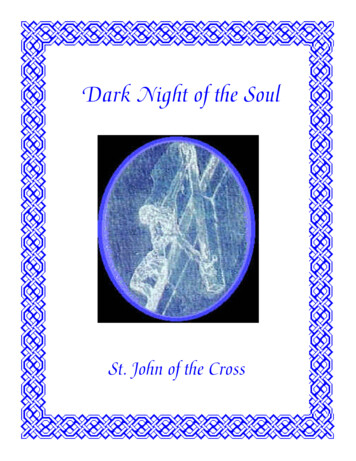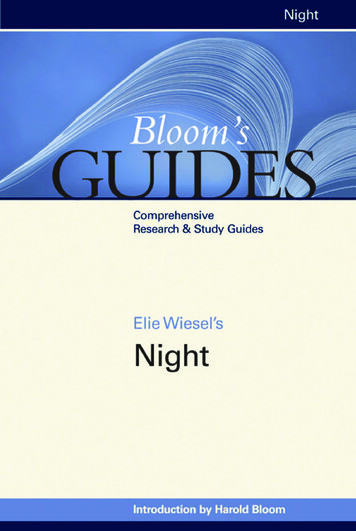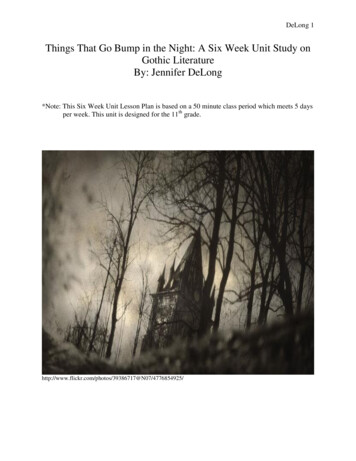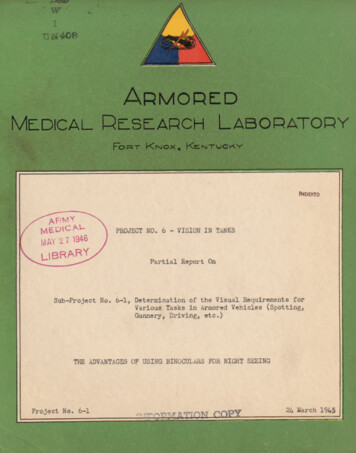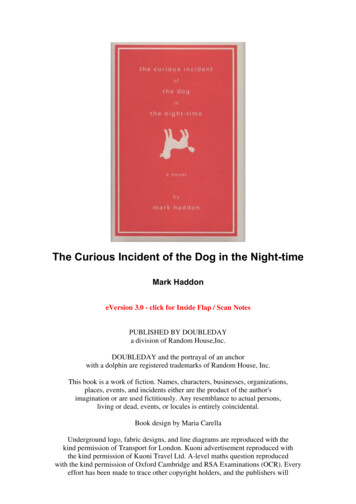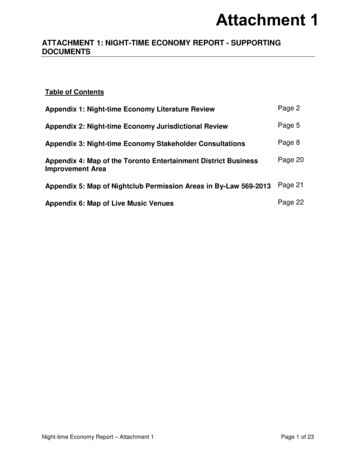
Transcription
Palaeontologia Electronicapalaeo-electronica.orgA night heron (Ciconiiformes, Ardeidae) and a stork (Ciconiidae)from the Pliocene of Myanmar (Burma)Thomas A. Stidham, Takehisa Tsubamoto, Zin-Maung-Maung-Thein,Thaung-Htike, Naoko Egi, Yuichiro Nishioka, Maung-Maung, and Masanaru TakaiABSTRACTTwo new avian specimens from the Pliocene part of the Irrawaddy sediments ofcentral Myanmar represent the youngest known fossil records of birds from Myanmar(Burma) that previously was restricted to one specimen of an ibis from the middleEocene. The age of the Sulegon-1 fossil locality is likely from the later part of the Pliocene based on the presence of the suid Sivachoerus prior, the anthracotheriid Merycopotamus dissimilis, and the Sumatran rhinoceros Dicerorhinus sp. cf. D. sumatrensis.The distal tarsometatarsus is from a night heron (Ardeidae: Nycticoracini) and exhibitsderived (and primitive) features consistent with night herons, but not other groups ofardeids, including the absence of a lateral deflection of trochlea III and a trochlear furrow extending to the proximal plantar end of trochlea III. The night heron fossil is notdistinguishable from some species of Gorsachius and Nycticorax and may derive fromone of the extant species in Southeast Asia. The other specimen (a distal tibiotarsus)represents a taxon of stork (Ciconiidae: cf. Leptoptilini) and displays many charactersassociated with that group (incuding a large centrally positioned intercondylar tubercle,a rounded intercondylar fossa, and distally notched trochlear rims). This stork issmaller than the ‘giant’ storks known from the Plio-Pleistocene of Asia and Africa, andmay represent a relative of one of the large extant Asian storks. The inferred paleohabitat of the Sulegon locality as a tidal deltaic habitat is consistent with the lifestyle of boththe extant night herons and large storks that occur in southeastern Asia today.Thomas A. Stidham. Key Laboratory for Vertebrate Evolution and Human Origins, Institute of VertebratePaleontology and Paleoanthropology, Chinese Academy of Sciences, Beijing 100044, China.presbyornis@gmail.comTakehisa Tsubamoto. Graduate School of Science and Engineering, Ehime University, 2-5 Bunkyo-cho,Matsuyama, Ehime Prefecture 790-8577, Japan. tsubamoto@sci.ehime-u.ac.jpZin-Maung-Maung-Thein. Department of Geology, Magway University, Magway, Magway Region,Myanmar. zmmtgeo@gmail.comThaung-Htike. Department of Geology, University of Mandalay, Mandalay, Mandalay Region, Myanmar.thaunghtikejp@gmail.comNaoko Egi. Primate Research Institute, Kyoto University, Inuyama, Aichi Prefecture 484-8506, Japan.egi.naoko.6z@kyoto-u.ac.jpStidham, Thomas A., Tsubamoto, Takehisa, Zin-Maung-Maung-Thein, Thaung-Htike, Egi, Naoko, Nishioka, Yuichiro, Maung-Maung,and Takai, Masanaru. 2016. A night heron (Ciconiiformes, Ardeidae) and a stork (Ciconiidae) from the Pliocene of Myanmar (Burma).Palaeontologia Electronica 19.2.36A: ene-birds-from-myanmarCopyright: October 2016 Society of Vertebrate Paleontology. This is an open access article distributed under the terms of theCreative Commons Attribution License, which permits unrestricted use, distribution, and reproduction in any medium, provided theoriginal author and source are credited.creativecommons.org/licenses/by/4.0/
STIDHAM ET AL.: PLIOCENE BIRDS FROM MYANMARYuichiro Nishioka. Waseda Institute for Advanced Study, Waseda University, 1-6-1 Nishi-Waseda,Shinjuku-ku, Tokyo 169-8050, Japan. nishioka@aoni.waseda.jpMaung-Maung. Department of Geology, Loikaw University, Loikaw Township, Kayah State, Myanmar.maungmaunggeol@gmail.comMasanaru Takai. Primate Research Institute, Kyoto University, Inuyama, Aichi Prefecture 484-8506,Japan. takai.masanaru.2s@kyoto-u.ac.jpKeywords: Aves; Pliocene; Myanmar; Ardeidae; Ciconiidae; paleoenvironmentSubmission: 26 January 2016 Acceptance: 17 August 2016INTRODUCTIONNeogene and Pleistocene birds from Southand Southeast Asia are relatively rare in the published fossil record. Recent reports of new taxa andspecimens from the Pleistocene of Indonesia (Meijer et al., 2013) are beginning to fill in both a taxonomic, as well as biogeographic picture of thishistorically complex region, and Meijer (2014)recently reviewed the fossil record of insular portions of Southeast Asia. Prior to those new finds,rather limited published pre-Quaternary specimensfrom the Siwalik Hills in India and Pakistan (e.g.,Davies, 1880; Harrison and Walker, 1982), theEocene lignite mines in India (e.g., Mayr et al.,2007), the early Miocene of Thailand (Chenval etal., 1991), a single specimen from the Eocene ofMyanmar (Stidham et al., 2005), the skeleton of thepelecaniform Protoplotus from Indonesia (Van Tetset al., 1989), and Oligocene avian tracks from Indonesia (Zonneveld et al., 2011) are the majority ofrecords from the region. However, ongoing fieldwork continues to produce Neogene and Quaternary avian material in southern Asia (e.g., Stidhamet al., 2014, Forestier et al., 2015), adding to theknown avian fossil material that was first publishedin the late nineteenth century. Despite that growingbody of research, at present there remains only asingle avian specimen (originally identified as anibis relative) published from the middle Eocene ofMyanmar (Burma) (Stidham et al., 2005).Adding to that sparse record from SouthernAsia (and Myanmar), we report two new avianspecimens from the Pliocene of Myanmar. Thesenew fossils record the presence of what likely are astork (Ciconiidae) and a night heron (Ardeidae),and furthermore, those fossils may derive fromspecies that occur in the same geographic areatoday. The discovery of apprarent relatives ofextant birds in the Pliocene of Myanmar contrastswith that of the stragraphic sequence’s mammalianfossil record (where most of the mammals knownare from extinct groups, with the exception of early2representatives of the Sumatran rhino), but is consistent with the Quaternary Liang Bua site in Indonesia, largely composed of extant avian taxa(Meijer et al., 2013).The pre-Quaternary record of herons, whileextending back into the Paleogene, is rathersparse (Scofield et al., 2010; Worthy et al., 2013).While some Paleogene specimens have been allocated as night herons (Scofield et al., 2010), noneof those specimens are from Asia. The fossilrecord of pre-Quaternary ardeids in Asia includesan unnamed bittern from the Miocene of Mongolia(Zelenkov, 2011), Nyctisoma robusta from the middle Miocene of Mongolia (Elzanowski and Zelenkov, 2015), Nyctanassa kobdoena from the earlyPliocene of Mongolia (Kurochkin, 1976; Zelenkov,2013), the early Miocene Proardeola walkeri fromThailand (Cheneval et al., 1991), a Miocene indeterminate vertebral centrum from China (Hou,1987), and the middle Miocene Ardea sytchevskayae from Mongolia (Zelenkov, 2011). Only one ofthose fossils is from southeastern Asia (Thailand).Large-bodied storks are known from severalsites across southern and eastern Asia in the Pliocene and Pleistocene. Traditionally, the largerstorks (species of Jabiru, Ephippiorhynchus, andLeptoptilos) have been placed within Leptoptilini.However, molecular phylogenetic analyses do notconsistently support the monophyly of Leptoptilini(Slikas, 1997, 1998), and a recent morphologicalanalysis (de Pietri and Mayr, 2014) demonstratedonly weak boostrap support for the group as whole.The large-bodied storks include the very large (oreven ‘giant’) storks of Leptoptilos falconeri (Harrison, 1974; Louchart et al., 2005) from India (andelsewhere), L. robustus from Flores Island, Indonesia (Meijer and Due, 2010; Meijer et al., 2013), L.titan (Wetmore, 1940) from Java, Indonesia, and L.lüi from northeastern China (Zhang et al., 2012).The largest of these extinct storks have beenhypothesized to stand 1.8 to 2 meters tall (Louchartet al., 2005; Meijier and Due, 2010). Some fossil
PALAEO-ELECTRONICA.ORGFIGURE 1. Map of Myanmar showing the SLG1 fossil locality (star) and geological map around the SLG locality (Geological map: after The Geological Map of Burma, 1: 1000,000 map; Earth Sciences Research Division, 1977).material also has been allocated to the extant species of L. dubius (Louchart et al., 2005) from India,and two species (Ephippiorhnychus cf. asiaticusand cf. L. dubius) were identified from the Trinil siteon Java (Weesie, 1982). Recently, the age of the L.robustus type locality was revised to an (older) ageof more than 50 ka (Sutikna et al., 2016).Geological SettingThe Neogene Irrawaddy sediments ( Fossilwood Group: Theobald, 1869; IrrawaddianSeries: Noetling, 1900; Irrawaddy Formation:Aung-Khin and Kyaw-Win, 1969; IrrawaddyGroup: Bender, 1983) are widely distributed alongthe Irrawaddy River ( Ayeyarwady River) in central Myanmar (Figure 1). They are mainly composed of fluviatile sediments that are characterizedby the abundance of silicified fossil woods, and thethickness has been estimated to be 2,000 to 3,000m (Bender, 1983; Wandrey, 2006). The Irrawaddysediments have been traditionally subdivided intothe “Lower Irrawaddy” and “Upper Irrawaddy”based on the lithological and paleontological criteria (Stamp, 1922; Colbert, 1938; Bender, 1983).The Lower Irrawaddy consists of cross-beddedsandstones, gravels, and pebbly red mudstone layers with carbonate and iron concretions. TheUpper Irrawaddy consists of abundant gravels andpoorly consolidated sandstones with few red mudstone layers.The geological age of the Irrawaddy sediments has been estimated by the correlation of thevertebrate faunas with those of the Siwalik Groupof Indo-Pakistan. The Lower Irrawaddy has beencorrelated to the upper Miocene to lower PlioceneDhok Pathan Formation of the Siwalik Group,although the base of the Lower Irrawaddy probablyextends to the middle Miocene because the baseyields some taxa of the Chinji Formation of theSiwalik Group (Cotter, 1938; Bender, 1983; Chavasseau et al., 2006). The Upper Irrawaddy hasbeen conventionally correlated to the lower Pleistocene (Colbert, 1938, 1943; Bender, 1983). However, its fauna shows close resemblance to thefaunas of the Tatrot and Pinjor Formations of theSiwalik Group, suggesting an upper Pliocene tolower Pleistocene correlation for the UpperIrrawaddy sediments (Zin-Maung-Maung-Thein etal., 2008).The new bird specimens come from theIrrawaddy sediments at the SLG1 locality(21 21'02"N; 094 40'12"E), Sulegon Village (SLG Sulegon), Pauk Township, Magway ( Magwe)Region, western part of central Myanmar (Figure 1;Zin-Maung-Maung-Thein et al., 2010; Tsubamotoet al., 2012). Geologically, it is located in the eastern part of the N-S trending axis of the Salin Syncline (Figure 1). The upper Miocene to the lowerPleistocene massive sandstones and gravels ofthe Irrawaddy sediments are exposed in the central3
STIDHAM ET AL.: PLIOCENE BIRDS FROM MYANMARpart, whereas the Miocene to Eocene depositscrop out in the eastern and western limbs of thesyncline (Figure 1). The sediments of the synclineare estimated to be more than 9,000 m thick, containing lithic sandstones that alternate with thetransgressive shallow marine shales (Trevena etal., 1991). The sedimentary facies and paleocurrent studies indicate a presence of north to southprograding tidal deltas (Rodolfo, 1975; Trevena etal., 1991). The SLG1 locality yielded some molluscan fossils, such as the freshwater gastropodMelannoides and freshwater bivalves Radiatulaand Parreysia (Ugai et al., 2006).The SLG1 locality has produced two birdbones, in addition to a larger sample of mammalianfossils. The Irrawaddy sediments at the SLG1locality are assigned to the Upper Irrawaddy sediments. The sediments at the locality produced severalmammalianfossilsrepresentedbyindeterminate Bovidae, the suid Sivachoerus prior,the anthracotheriid Merycopotamus dissimilis, therhinoceros Dicerorhinus sp. cf. D. sumatrensis sp.,and the proboscidean Stegodon sp. (Zin-MaungMaung-Thein et al., 2010; Tsubamoto et al., 2012).This faunal assemblage has been correlated withthe Tatrot and Pinjor Formations of the SiwalikGroup, suggesting an age of the Pliocene to earlyPleistocene (Zin-Maung-Maung-Thein et al., 2010).The presence of Sivachoerus prior potentially indicates a solely Pliocene age of this fauna (Tsubamoto et al., 2012), but Barry and others (2013)state the stratigraphic range of that species as 3.5to 2.1 Ma, Pliocene to early Pleistocene. The stratigraphic range of the anthracotheriid Merycopotamus dissimilis in Pakistan is 7.8 – 3.3 Ma (Barry etal., 2013), and the oldest Dicerorhinus sp. cf. D.sumatrensis from Myanmar is thought to beapproximately 3 Ma (Zin-Maung-Maung-Thein etal., 2010). Furthermore, Badgley et al. (2008)hypothesized that the Merycopotamus lineage mayhave survived to 2.2 Ma, as opposed to its lastrecorded appearance datum at 3.3 Ma. Giventhose various stratigraphic ranges across Asia, itwould seem likley that the Sulegon-1 locality sediments and fossils derive from the later part of thePliocene ( 3 – 4 Ma).Repository InformationThe designation “NMMP-KU-IR” stands for theNational Museum of Myanmar Paleontology-KyotoUniversity-Irrawaddy. The fossil bird specimenscurrently are housed in Southern Branch, theNational Museum and Library Department (formerly Department of Archaeology), Ministry of Cul4ture, Yangon, Myanmar. These specimens werecollected by the Kyoto University (Japan) andMyanmar Government Joint Paleontological Expedition in February 2005. MVZ – Museum of Vertebrate Zoology, University of California, Berkeley,USA. NMNH – National Museum of Natural History, Washington, D.C., USA.SYSTEMATIC PALEONTOLOGYOrder CICONIIFORMES Bonaparte, 1854Family ARDEIDAE Leach, 1820Tribe cf. NYCTICORACINI Bock, 1956Figure 2Specimen. NMMP-KU-IR 0343 is a distal tarsometatarsus.Description. The specimen is the distal end of aright tarsometatarus broken near where the facetfor metatarsal I would be positioned (Figure 2). Thedistal mediolateral width of the specimen is 10.1mm, and the mediolateral wi
and the proboscidean Stegodon sp. (Zin-Maung-Maung-Thein et al., 2010; Tsubamoto et al., 2012). This faunal assemblage has been correlated with the Tatrot and Pinjor Formations of the Siwalik Group, suggesting an age of the Pliocene to early Pleistocene (Zin-Maung-Maung-Thein et al., 2010). The presence of Sivachoerus prior potentially indi-


